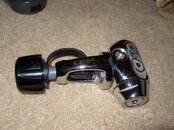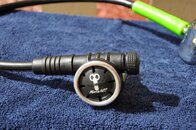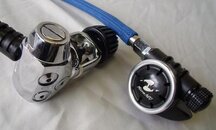You are using an out of date browser. It may not display this or other websites correctly.
You should upgrade or use an alternative browser.
You should upgrade or use an alternative browser.
scored used aqualung regs+octo...good score or not?
- Thread starter Aotus
- Start date
Please register or login
Welcome to ScubaBoard, the world's largest scuba diving community. Registration is not required to read the forums, but we encourage you to join. Joining has its benefits and enables you to participate in the discussions.
Benefits of registering include
- Ability to post and comment on topics and discussions.
- A Free photo gallery to share your dive photos with the world.
- You can make this box go away
- Messages
- 17,699
- Reaction score
- 9,971
- Location
- Somewhere between here and there
- # of dives
- 2500 - 4999

That's just the label they've used on the yoke knob. I'm pretty sure your first stage is a Coustea-SEA, assuming it looks like this: I've owned this reg. To my knowledge there is no "Micra" Aqualung or US Divers 1st stage. I could of course be wrong but I'm pretty sure I'm not mistaken. I'm open to being corrected. It is a little hard to be 100% sure of 1st stage from your photos. To the best of my knowledge the Micra and Micra ADJ came with two different 1st stages, a cheaper Titan (older version/now "updated") and the Cousteau, more expensive (no longer made/ no "updates")
- Messages
- 17,699
- Reaction score
- 9,971
- Location
- Somewhere between here and there
- # of dives
- 2500 - 4999
- Messages
- 17,699
- Reaction score
- 9,971
- Location
- Somewhere between here and there
- # of dives
- 2500 - 4999
It can be sealed and converted to DIN but I imagine the cost would not be worth it. Personally I'd keep the set and dive it until you get into tech and then keep it as a back up/spare/set for the kids/wife etc. If it was the ADJ Micra I would have made you an offer lol.
---------- Post added May 9th, 2014 at 10:35 AM ----------
You can see the wider exhaust T in the second photo.
---------- Post added May 9th, 2014 at 10:35 AM ----------
You can see the wider exhaust T in the second photo.
claymore
Contributor
The 1st stage is the Cousteau/SEA it was available in Yoke, DIN and/or with the Dry Sealed Environmental seal (I have had several of the Couseau/SEA in various configurations.) It was paired with multiple 2nd stages in it's lifetime, Micra, Glacia, Sea and ?. The Micra 2nd came in 2 versions, the base and the adjustable.
I am with Herman keep the regs for recreational use, the money you get for them would not even pay for a class. You are looking at thousands of dollars in training and gear to get into Cave/Tech diving.
I am with Herman keep the regs for recreational use, the money you get for them would not even pay for a class. You are looking at thousands of dollars in training and gear to get into Cave/Tech diving.
ams511
Contributor
Lets look at this objectively, if he sells the regulators I would estimate he would get $75, he would also avoid the servicing them which would be probably $125 (I am being conservative the cost could be much higher), that is $200. For $70 more he can get this. Which would also include proper length Hogatharian hoses and a din fitting (plus a yoke adapter) for the regulator. Once he decides on doubles he can just buy another first stage. This you cannot do with the Micra set, it is a dead end and even if it wasn't once you add the Din fitting and hoses you are over the cost of a new set. If he doesn't want HOG I am sure he can get a similar deal on the Hollis closeout regulators.
I think some of you are letting your admiration for Aqualung products cloud your judgement. I think others are trying to persuade the OP not to get cave training even though he desires to be a scientific diver. Again the cave training decision is between him and his instructor. How any of you can evaluate his skills and attitude from your homes and offices is beyond me. I am amazed at your powers of clairvoyance.
---------- Post added May 9th, 2014 at 08:21 AM ----------
When dealing with Aqualung/US Divers equipment you need to be careful. One thing AL/US liked to do is use oversize 1/2: LP ports that require special hoses or adapters to use regular hoses. As was pointed out this first stage was mated with various second stages though-out its long life. I know is some variations it used 1/2 ports. Sometimes the same model of regulator can have different port setups for example I have an SE2 with 4 1/2 ports and another with only 1 1/2 port the rest being the normal 3/8". Even if you keep the regulator you are looking at $50 or more for service plus another $75 or so to convert it to DIN when the time comes. This first stage may be a classic but it performs no better than a modern high-quality first would and as Herman says most of the performance you feel from the second stage anyway.
---------- Post added May 9th, 2014 at 08:29 AM ----------
Herman can explain the history of the corporate structure of Aqua-Lung better than I can but in the early 90s they were branded as US Divers here in the US. I am not sure of the exact date of when they started to use the Aqualung name in the US. Currently, they use the US Divers brand for snorkel gear.
I think some of you are letting your admiration for Aqualung products cloud your judgement. I think others are trying to persuade the OP not to get cave training even though he desires to be a scientific diver. Again the cave training decision is between him and his instructor. How any of you can evaluate his skills and attitude from your homes and offices is beyond me. I am amazed at your powers of clairvoyance.
---------- Post added May 9th, 2014 at 08:21 AM ----------
if this first stage is so good, think I should separate the set and ebay each piece off individually?
When dealing with Aqualung/US Divers equipment you need to be careful. One thing AL/US liked to do is use oversize 1/2: LP ports that require special hoses or adapters to use regular hoses. As was pointed out this first stage was mated with various second stages though-out its long life. I know is some variations it used 1/2 ports. Sometimes the same model of regulator can have different port setups for example I have an SE2 with 4 1/2 ports and another with only 1 1/2 port the rest being the normal 3/8". Even if you keep the regulator you are looking at $50 or more for service plus another $75 or so to convert it to DIN when the time comes. This first stage may be a classic but it performs no better than a modern high-quality first would and as Herman says most of the performance you feel from the second stage anyway.
---------- Post added May 9th, 2014 at 08:29 AM ----------
apparently they were labeled as both at some point...
Herman can explain the history of the corporate structure of Aqua-Lung better than I can but in the early 90s they were branded as US Divers here in the US. I am not sure of the exact date of when they started to use the Aqualung name in the US. Currently, they use the US Divers brand for snorkel gear.
As you say, he may be able to get as much as $75. But IMHO, if he really wants to learn about diving, learning how to service his own regulators is not a bad thing. That would save the service cost even if he has a to buy a few tools.
In his present budget, used gear and learning how to do his own service is not a bad way to go (again, just my opinion).
I don't see the $75 from selling the regulator, making a dent in the budget he needs.
I totally support his goals, but this could never be a quick turnaround process. He is not talking about just cave diving. He is also talking about scientific diving.
In his present budget, used gear and learning how to do his own service is not a bad way to go (again, just my opinion).
I don't see the $75 from selling the regulator, making a dent in the budget he needs.
I totally support his goals, but this could never be a quick turnaround process. He is not talking about just cave diving. He is also talking about scientific diving.
ams511
Contributor
About the question above: In the 70's US Divers made Calypso III, the Calypso IV, and the Calypso J (the J was the same as the other, but it had built in reserve, which could be added to the others). The 1970's Calypso were all flow through balanced piston regulators. They were basically sold as US Divers top of the line regulators.
Thanks for the lesson. I actually forgot about the older Calypso regulators. I remember they had the old unbalanced Aquarius which went through many stages until they renamed it Calypso.
Before the Aquarius they also had the Deepstar and the Deepstar II. The Deepstar was kind of similar to the Scubapro Mk-2. It was a small un-balanced piston, a decent regulator.
The Deepstar II was a totally different story. It was an un-balanced piston, but it a was a very unique female synthetic (plastic) piston. The piston surrounded the tiny HP chamber and therefore there was no way to design a path for a HP port. The regulator came out around 1970. At the time having a new regulator without a high pressure port for an SPG didn't make any sense. It was a total financial failure. I own one in my collection, it is an interesting conversation piece.
---------- Post added May 9th, 2014 at 12:49 PM ----------
Sorry for the off-topic post.
The Deepstar II was a totally different story. It was an un-balanced piston, but it a was a very unique female synthetic (plastic) piston. The piston surrounded the tiny HP chamber and therefore there was no way to design a path for a HP port. The regulator came out around 1970. At the time having a new regulator without a high pressure port for an SPG didn't make any sense. It was a total financial failure. I own one in my collection, it is an interesting conversation piece.
---------- Post added May 9th, 2014 at 12:49 PM ----------
Sorry for the off-topic post.
Similar threads
- Replies
- 4
- Views
- 620
- Replies
- 1
- Views
- 1,028









